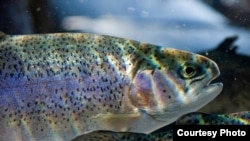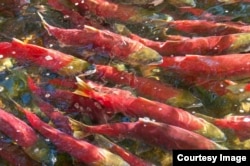Once a luxury item, salmon is now among the most popular fish consumed in North America, Europe and Japan.
Since 1980, production of farmed raised salmon has tripled, accounting for 70 percent of the world market.
The genetic sequence of the Atlantic salmon announced Tuesday could help improve aquaculture operations and better conserve wild salmon stocks.
Salmon is big business, and fishery managers want to keep those stocks healthy.
Mapping its genome will improve salmon production in a sustainable way, says Steinar Bergseth, who chaired the International Cooperaton to Sequence the Atlantic Salmon Genome (ICSASG) that did the work.
“In the sequence, in the genetic material are the codes for determining its health, its look, its utilization of food and so on and so forth," said Bergseth, "so to be able to understand this relation between the genetics and the biology then we need to sequence the salmon."
While the size of its genome is about the same as a human’s, the salmon’s genetic code is more complicated. Instead of two copies of each gene, the salmon has four.
“And of course that is quite obvious that makes some challenges, not only some, but rather big challenges to understand what you are sequencing relating to these four copies,” Bergseth said.
And the very long repeated sequences made the work even more arduous.
The scientists applied tools used for the human genome project and developed new analytical instruments.
Bergseth says now that the genome is sequenced, the work to understand salmon biology is just beginning.
“We could understand, for instance, the sex determination in the salmon and produce sterile salmon, which would be very beneficial for this interaction between the escaped farmed salmon and the wild salmon," he said. "And of course then this problem with cross breeding between the farmed and the wild will disappear.”
The sequence is also certain to trigger work on other species closely related to Atlantic salmon like the Pacific salmon, trout and char.
The five-year $10 million project is a collaboration among government and industry partners in Canada, Norway and Chile.
Since 1980, production of farmed raised salmon has tripled, accounting for 70 percent of the world market.
The genetic sequence of the Atlantic salmon announced Tuesday could help improve aquaculture operations and better conserve wild salmon stocks.
Salmon is big business, and fishery managers want to keep those stocks healthy.
Mapping its genome will improve salmon production in a sustainable way, says Steinar Bergseth, who chaired the International Cooperaton to Sequence the Atlantic Salmon Genome (ICSASG) that did the work.
“In the sequence, in the genetic material are the codes for determining its health, its look, its utilization of food and so on and so forth," said Bergseth, "so to be able to understand this relation between the genetics and the biology then we need to sequence the salmon."
While the size of its genome is about the same as a human’s, the salmon’s genetic code is more complicated. Instead of two copies of each gene, the salmon has four.
“And of course that is quite obvious that makes some challenges, not only some, but rather big challenges to understand what you are sequencing relating to these four copies,” Bergseth said.
And the very long repeated sequences made the work even more arduous.
The scientists applied tools used for the human genome project and developed new analytical instruments.
Bergseth says now that the genome is sequenced, the work to understand salmon biology is just beginning.
“We could understand, for instance, the sex determination in the salmon and produce sterile salmon, which would be very beneficial for this interaction between the escaped farmed salmon and the wild salmon," he said. "And of course then this problem with cross breeding between the farmed and the wild will disappear.”
The sequence is also certain to trigger work on other species closely related to Atlantic salmon like the Pacific salmon, trout and char.
The five-year $10 million project is a collaboration among government and industry partners in Canada, Norway and Chile.









